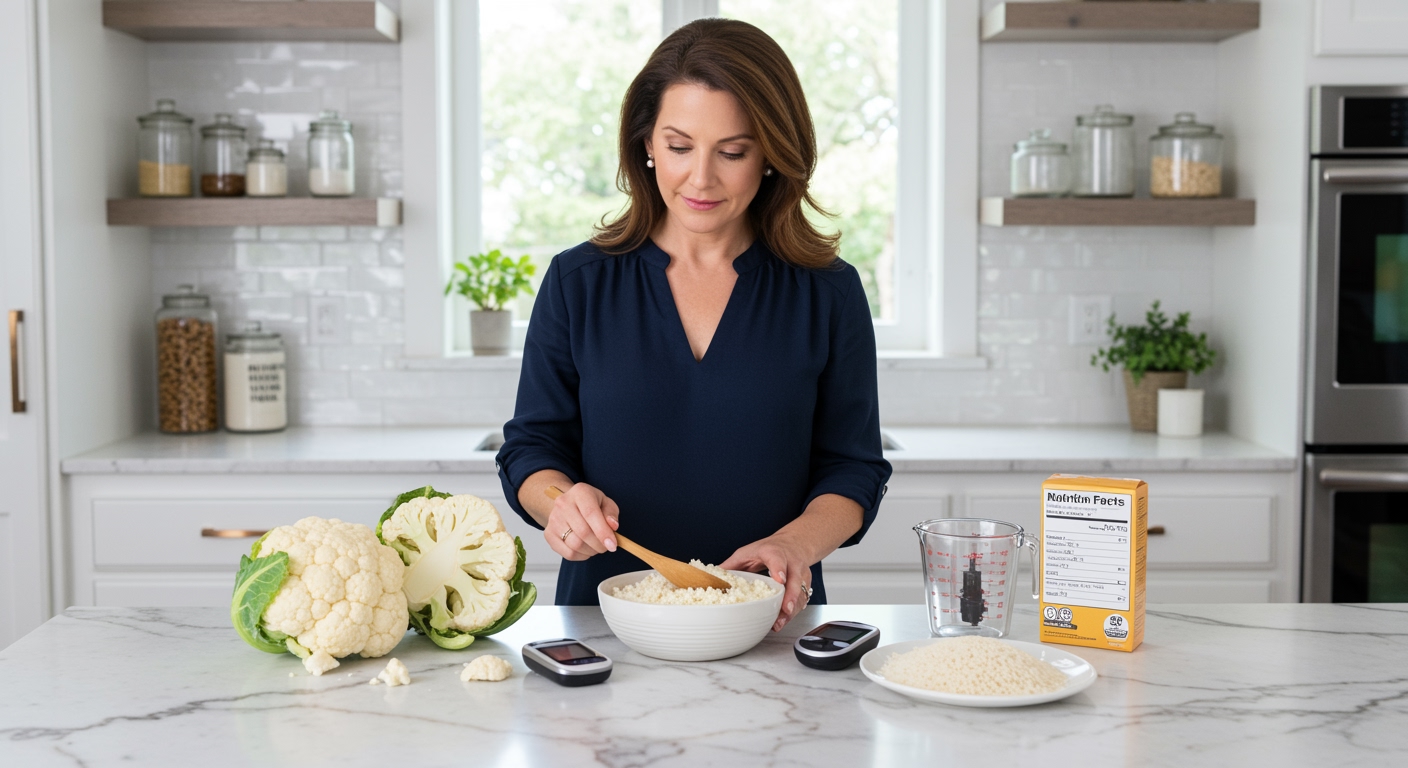✪ Key Takeaway: Cauliflower rice is excellent for diabetes with only 5 grams of carbs per cup versus 45 grams in regular rice.
Introduction
Your doctor just told you to watch your carbs, and suddenly rice feels like the enemy.
You might be wondering if cauliflower rice is really the miracle substitute everyone claims it to be for diabetes management.
Hi, I’m Abdur, your nutrition coach and today I’m going to explain exactly how cauliflower rice affects your blood sugar and whether it deserves a permanent spot on your diabetes-friendly plate.
How Does Cauliflower Rice Compare to Regular Rice?
The numbers tell a powerful story that every diabetic needs to understand.
One cup of cooked white rice contains about 45 grams of carbohydrates and has a glycemic index of 73, which means it spikes your blood sugar rapidly.
In contrast, one cup of cauliflower rice contains only 5 grams of carbohydrates with a glycemic index of just 15.
This massive difference means cauliflower rice causes minimal blood sugar elevation compared to regular rice.
The fiber content in cauliflower rice also helps slow down sugar absorption, providing additional blood sugar stability.
Regular rice gets broken down quickly into glucose, while cauliflower rice provides sustained energy without the dramatic blood sugar rollercoaster.
This makes cauliflower rice an excellent choice for maintaining steady glucose levels throughout your meal.
✪ Fact: Cauliflower rice has 90% fewer carbs than regular rice, making portion control much easier for diabetics.
What Makes Cauliflower Rice Diabetes-Friendly?
The secret lies in cauliflower’s unique nutritional composition that works in your favor.
Cauliflower contains sulforaphane, a compound that may help improve insulin sensitivity and glucose metabolism.
The high water content in cauliflower rice helps you feel full without adding extra calories or carbs to your meal.
Unlike regular rice, cauliflower rice provides vitamin C, vitamin K, and folate, which support overall metabolic health.
The antioxidants in cauliflower may help reduce inflammation, which is often elevated in people with diabetes.
Most importantly, cauliflower rice allows you to enjoy larger portions without worrying about blood sugar spikes.
This psychological benefit cannot be understated because it helps you stick to your diabetes management plan long-term.
✪ Pro Tip: Steam cauliflower rice for 3-4 minutes to achieve the perfect texture that mimics regular rice.
Are There Any Downsides to Consider?
Every food choice comes with considerations, and cauliflower rice is no exception.
Some people experience digestive discomfort when they first introduce large amounts of cauliflower rice due to its fiber content.
The taste difference can be significant, and it may take time to adjust your palate to this rice substitute.
Cauliflower rice has a different texture that some people find less satisfying than traditional rice.
If you take blood thinning medications, the vitamin K in cauliflower might interact with your medication, so consult your doctor.
The preparation time for fresh cauliflower rice is longer than cooking regular rice, which might be inconvenient for busy schedules.
However, these minor drawbacks pale in comparison to the blood sugar benefits for most diabetics.
✪ Note: Start with small portions of cauliflower rice and gradually increase to avoid digestive upset.
How Should You Prepare Cauliflower Rice for Best Results?
The preparation method significantly impacts both taste and blood sugar response.
Always drain excess water from cauliflower rice after cooking to prevent a mushy texture that might make you crave regular rice.
Season generously with herbs and spices like garlic, turmeric, and cumin to enhance flavor without adding carbs.
Cook cauliflower rice in a dry pan for 2-3 minutes after steaming to remove moisture and improve texture.
Add a small amount of healthy fats like olive oil or coconut oil to help with nutrient absorption and satiety.
Mix cauliflower rice with protein sources like grilled chicken or tofu to create a complete, blood sugar-friendly meal.
Avoid adding sugary sauces or high-carb ingredients that would negate the blood sugar benefits of choosing cauliflower rice.
✪ Pro Tip: Freeze cauliflower rice portions in advance for quick diabetes-friendly meals throughout the week.
The Bottom Line
Cauliflower rice is genuinely excellent for diabetes management because it provides the satisfaction of rice without the blood sugar chaos.
Smart food swaps like cauliflower rice prove that managing diabetes does not mean sacrificing the foods you love, just finding better versions of them.
I would love to hear about your experience with cauliflower rice or any questions you might have about incorporating it into your diabetes meal plan, so please share your thoughts in the comments below.
References
At NutritionCrown, we use quality and credible sources to ensure our content is accurate and trustworthy. Below are the sources referenced in creating this article:
- Tap Health: Is Cauliflower Rice Good for Diabetics? A Healthy Low-Carb Alternative
- January AI: Cauliflower Rice Glycemic Index
- OSU Wexner Medical Center: Diabetes-Friendly Cauliflower Rice
- Ultrahuman: Cauliflower Rice: A Double-Edged Sword for Glucose Control





